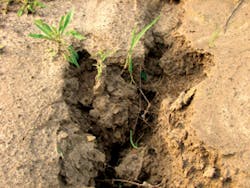We can’t always put a dollar amount on things we value, or say with certainty how much money bad practices are costing us-but occasionally we can. A serious reckoning is going on right now in the Midwest, and the news about the price of soil loss is fairly grim: a billion dollars a year, give or take, in Iowa alone. There are ways to fix it, though.
Earlier this year, Rick Cruse, a professor of agronomy at Iowa State University, gained national attention with that billion-a-year estimate. He is using a sophisticated model to show the long-term effects of topsoil loss. He hopes that by showing farmers and, perhaps more importantly, landowners exactly what erosion is costing over the long haul, he can convince them to take more serious measures to prevent it.
The soil lost from the state in any given year, about 5.4 tons, might be no more than the thickness of a dime-hardly worth worrying about, many would say. Still, in some parts of the state the erosion rate is 12 times what the government has estimated it to be. Over time it adds up to significant loss of productive agricultural topsoil and has a very real effect on crop yields. To put that billion dollars in perspective, Iowa’s annual crop production is about $20 billion, and agriculture makes up about a quarter of the state’s economy.
Cruse and his colleagues believe that a number of things are contributing to the erosion rate. Fewer farmers are taking advantage of federal conservation programs-programs that encourage things like planting buffer strips along streams, or that pay farmers for taking extremely erodible land out of production and protecting it with grasses and trees that help hold the soil. In turn, there are a couple of reasons for the decline in program participation. One is that some farmers, eager for the high prices they can get from planting corn and soybeans, are reluctant to set land aside. Another is that less federal funding is available for such programs in general.
In addition, as Cruse noted in a Des Moines Register interview in May, much of the farmland is rented out, and the tenants might not have a long-term interest in its health; they’re more concerned with getting the most out of a field in the year they’re working it. One effect of his model, ideally, will be to convince landowners that they need to take the long view.
The model being used in Iowa tracks what’s going on farm by farm, using satellite imagery to show what types of conservation efforts if any are being taken, as well as soil type, topography of the field, type of tillage used, and other factors. That information is matched to precipitation data. Finally, soil depth measurements taken on ag lands throughout the state are correlated to crop yields for those same areas over a period of several years. Taken altogether, the data allow Cruse and his research team to determine the economic impact of soil loss.
Coincidentally, the United Nations has designated 2015 the International Year of Soils, www.fao.org/globalsoilpartnership/iys-2015/en/, with the goal of bringing recognition to the value of soil as a resource and to highlight the need for conservation.
Are you aware of erosion estimates for your state or region? Or the participation rate in programs such as the federal Conservation Reserve Program? In addition to the more obvious benefits of soil conservation, what are the potential ramifications of this work in reducing the nutrient-laden runoff that contribute to dead zones in the Gulf of Mexico and elsewhere? Share your thoughts in the comment section below!About the Author
Janice Kaspersen
Janice Kaspersen is the former editor of Erosion Control and Stormwater magazines.



